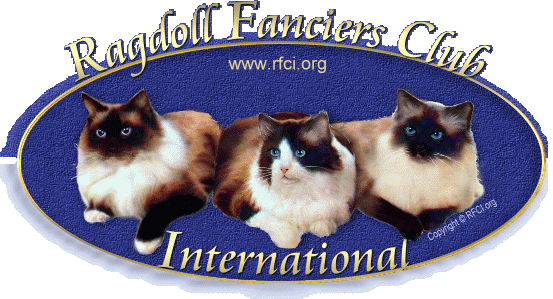HISTORY OF THE RAGDOLL
Chapter Two The Early Years
Ragdolls became recognized as a pure breed in 1966 when Ann Baker registered
Kyoto & Tike as the first Ragdolls in the National Cat Fanciers Association
NCFA. They were registered December 30, 1966 with Ann Baker listed as both
breeder and owner. Daddy Warbucks & Fugianna was registered the same
day with Merle Pennels listed as breeder and Ann Baker as owner.
At the beginning of the breed it was of utmost importance to keep inbreeding
to a minimum but still further advance the gene pool. Therefore a "light
side" and a "dark side" (not related to color) was established.
A high percentage of better litters were achieved when employing the light
side to dark side theory. Fugianna would be the light side and Buckwheat
would be the dark side.
Ann Baker said that the light side ones have a little longer nose and longer
sharper ears like the Balinese. The dark ones grow to look like Himalayan,
broader face, shorter ears, stockier build etc. The others look like the
sacred Cat of Burma, and that the 7th generation Ragdoll would all look like
Kyoto. For pets, the light side ones are wonderful and seem to have a little
more of the disposition than the darker ones. We need to remember that Fugianna
and Buckwheat did not come from the same parents, so they had very diverse
genes. Ann felt that you needed to breed one from each side to get that real
Ragdoll look.
Ann Baker claims that she bred only seal Ragdolls for the first 7 years,
however she contradicts this by writing that the first lilac (which was actually
a blue) was Thumper Jr. born 4/27/69. So how did Ann get the lilac/blue?
She claims that she got them by using a reversal process with the original
mother, and from this a beautiful true lilac color was developed. This process
was so successful, that the same process was tried on the dark side of the
original three, and a black point was developed. She claimed that there would
never be a blue or chocolate point.
You have to keep in mind that when Ann started working on developing the
Ragdoll breed, she was at the time working with her black Persians and apple
head lilac balinese. In two letters sent to Blanche Herman she tells Blanche
about her experimental lilac program using her apple head Balinese. Later
she claims to Blanche that someone had stolen all her lilac Balinese, as
they thought that they were getting Ragdolls. She said that 95% of the lilac
experimental program that she was breeding were born with kinks in their
tails. She asked Blanche not to tell anyone about her outcross program to
bring in the lilac color. She felt that the lilac/blue Ragdolls were on the
extreme light side. She claimed that in her conflict with the Daytons that
her lilac program was her ace in the hole.
Ann Baker knew very little about genetics, she was what you might call a
fly by the seat of your pants type of breeder. According to her she used
a lilac male apple head Balinese and bred it to several Ragdoll females and
then bred the females from this back to Ragdoll males.
Ann Baker was a business lady FIRST, and a breeder second. If you saw the
picture of her home which she used for her cattery in the last issue of the
RW, you saw the house where she gave sightseeing tours of her cattery.
TOUR FEES where:
$1.00 for adults and .50 for children.
Tours were given 7 days a week 1 to 5 PM
The next BIG event in Ragdoll history was Ann Bakers attempt to totally
control the Ragdoll breed by Franchising it. She wanted to be the MacDonalds
of the cat world. She felt that this would create a source of income for
her, for as long as she lived. The Franchise document & Prospectus is
8 pages long, I am only including the territory & monetary portion of
it. The concept of her franchise went like this:
1. Breeders of Ragdolls would be limited to one breeder per state. A 50
mile limit would hold regardless of state boundary line.
2. Ragdoll breeders would be limited to only 12 breeders in the world.
3. Prices for Ragdolls would be:
$150.00 Masked marking/bicolor
$175.00 Himalayan markings/colorpoint
$225.00 Sacred cat of Burma markings/mitted
$275.00 Show quality
4. No less than $500.00 down payment can be accepted on breeding pairs (ties
up territory for others). Absolutely no delivery until entirely paid for.
5. On the birth of any Ragdoll cat the franchisees shall, within three months
send litter information to Franchiser and pay Franchiser $5.00 for each kitten.
6. The Franchisee shall have the option to join IRCA for a fee of $10.00.
7. The cost of the breeding pair is $1000.00 and the Franchise fee is $1500.00
Ann was to learn that there was a downside to having a Franchise and being
the Franchiser. She was to decide in 1976 that it would be best to discontinue
the Franchise. Her reasoning for this was that the Franchise was very expensive
and required an attorney for everything, plus charges for all changes that
she was making. She said that "it gave protection to the buyers like
you would not believe, but absolutely none to the Franchisor." She also
found that it was very expensive to set up franchises in each state. The
only state other than California that she set one up in was Indiana for Blanche
Herman.
Pictures and text copyright © 2006 Wain Pearce, General
Historian / RFCI.
May not be reprinted/published without authors express written permission.
All rights reserved.
|

